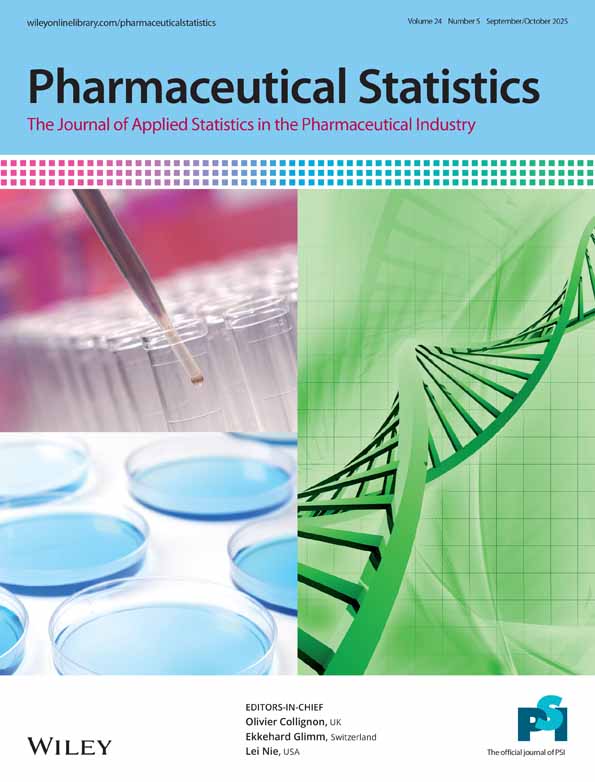Gaining acceptability for the Bayesian decision-theoretic approach in dose-escalation studies
Corresponding Author
Yinghui Zhou
Medical and Pharmaceutical Statistics Research Unit, University of Reading, Reading RG6 6FN, UK
MPS Research Unit, University of Reading, Reading, RG6 6FN, U.K.Search for more papers by this authorMaria Lucini
Medical and Pharmaceutical Statistics Research Unit, University of Reading, Reading RG6 6FN, UK
Search for more papers by this authorCorresponding Author
Yinghui Zhou
Medical and Pharmaceutical Statistics Research Unit, University of Reading, Reading RG6 6FN, UK
MPS Research Unit, University of Reading, Reading, RG6 6FN, U.K.Search for more papers by this authorMaria Lucini
Medical and Pharmaceutical Statistics Research Unit, University of Reading, Reading RG6 6FN, UK
Search for more papers by this authorAbstract
There has recently been increasing demand for better designs to conduct first-into-man dose-escalation studies more efficiently, more accurately and more quickly. The authors look into the Bayesian decision-theoretic approach and use simulation as a tool to investigate the impact of compromises with conventional practice that might make the procedures more acceptable for implementation. Copyright © 2005 John Wiley & Sons, Ltd.
REFERENCES
- 1 Zhou Y, Whitehead J. Practical implementation of Bayesian dose-escalation procedures. Drug Information Journal 2003; 37: 45–59.
- 2 Patterson S, Francis S, Ireson M, Webber D, Whitehead J. A novel Bayesian decision procedure for early phase dose-finding studies. Journal of Biopharmaceutical Statistics 1999; 9: 583–597.
- 3 Whitehead J, Zhou Y, Patterson S, Webber D, Francis S. Easy-to-implement Bayesian methods for dose-escalation studies in healthy volunteers. Bio-statistics 2001; 2: 47–61.
- 4 Carter SK. Study design principles for the clinical evaluation of new drugs as developed by the chemotherapy programme of the National Cancer Institute. In The Design of Clinical Trials in Cancer Therapy, MJ Staquet (ed.). Scientifiques Européennes: Brussels, 1973, pp. 242–289.
- 5 Lin Y, Shih WJ. Statistical properties of the traditional algorithm-based designs for phase I cancer clinical trials. Biostatistics 2001; 2: 203–215.
- 6 Kang SH, Ahn CW. An investigation of the traditional algorithm-based designs for phase I cancer clinical trials. Drug Information Journal 2002; 36: 865–873.
- 7 O'Quigley J, Pepe M, Fisher L. Continual reassessment method: a practical design for phase I clinical trials in cancer. Biometrics 1990; 46: 33–48.
- 8 Faries D. Practical modifications of the continual reassessment method for phase I cancer clinical trials. Journal of Biopharmaceutical Statistics 1994; 4: 147–164.
- 9 Korn EL, Midthune D, Chen TT, Rubinstein LV, Christian MC, Simon RM. A comparison of two phase I designs. Statistics in Medicine 1994; 13: 1799–1806.
- 10 Goodman SN, Zahurak ML, Piantadosi S. Some practical improvements in the continual reassessment method for phase I studies. Statistics in Medicine 1995; 14: 1149–1161.
- 11 Moller S. An extension of the continual reassessment methods using a preliminary up-and-down design in a dose finding study in cancer patients, in order to investigate a greater range of doses. Statistics in Medicine 1995; 14: 911–922.
- 12 Ahn C. An evaluation of phase I cancer clinical trial design. Statistics in Medicine 1998; 17: 1537–1549.
10.1002/(SICI)1097-0258(19980730)17:14<1537::AID-SIM872>3.0.CO;2-F CAS PubMed Web of Science® Google Scholar
- 13 Heyd JM, Carlin BP. Adaptive design improvements in the continual reassessment method for phase I studies. Statistics in Medicine 1999; 18: 1307–1321.
10.1002/(SICI)1097-0258(19990615)18:11<1307::AID-SIM128>3.0.CO;2-X CAS PubMed Web of Science® Google Scholar
- 14 O'Quigley J, Reiner E. A stopping rule for the continual reassessment method. Biometrika 1998; 85: 741–748.
- 15 Zohar S, Chevret S. The continual reassessment method: comparison of Bayesian stopping rules for dose-ranging studies. Statistics in Medicine 2001; 20: 2827–2843.
- 16 O'Quigley J, Shen LZ. Continual reassessment method: a likelihood approach. Biometrics 1996; 52: 673–684.
- 17 Zhou Y, Whitehead J. Practical implementation of Bayesian dose-escalation procedures. Journal of the Drug Information Association 2003; 37: 45–59.
- 18 Whitehead J, Brunier H. Bayesian decision procedures for dose determining experiments. Statistics in Medicine 1995; 14: 885–893.
- 19 Whitehead J. Bayesian decision procedures with application to dose-finding studies. International Journal of Pharmaceutical Medicine 1997; 11: 201–208.
- 20 Whitehead J, Williamson D. An evaluation of Bayesian decision procedures for dose-finding studies. Journal of Biopharmaceutical Statistics 1998; 8: 445–467.
- 21 Tsutakawa RK. Bayesian inference for bioassay. Technical report 52. Mathematical Sciences, University of Missouri, Columbia, 1975.
- 22 Haines LM, Perevozskaya I, Rosenberger WF. Bayesian optimal designs for phase I clinical trials. Biometrics 2003; 59: 591–600.
- 23 Zhou Y, Whitehead J. Bayesian ADEPT: Operating Manual. The University of Reading, 2002.
- 24 Zhou Y. Choosing the number of doses and the cohort size for phase I dose-escalation studies. Drug Information Journal (to appear).
- 25 Ferry DR, Smith A, Malkandi J, Fyfe DW, Detakats PG, Anderson D, Baker J, Kerr DJ. Phase I clinical trial of the flavonoid quercetin – pharmacokinetics and evidence for in vivo tyrosine kinase inhibition. Clinical Cancer Research 1996; 2: 659–668.




